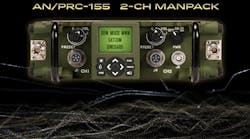Using the same technology that powers consumer smartphones, military and government personnel should eventually be able to make secure calls and exchange critical information via satellite. Among the efforts driving these capabilities forward is the US Navy’s Mobile User Objective System (MUOS). This narrowband tactical satellite-communications system is designed to significantly improve ground communications for US forces on the move. In a recent test, a military radio communicated with the MUOS space-ground network for the first time.
At the heart of this MUOS end-to-end system test were two AN/PRC-155 Manpack radios from General Dynamics C4 Systems (see photo). Using the final version of the MUOS waveform, one of the two-channel radios successfully transmitted voice and data communications to the orbiting MUOS satellite, through the MUOS ground station, and back to a second PRC-155 Manpack radio. The PRC-155 Manpack radios also demonstrated the capability of allowing soldiers to network their communications using the MUOS system.
According to General Dynamics, its non-proprietary MUOS waveform—which was used for the test—delivers high-speed voice and data communications at 16X greater capacity than the military’s current Ultra High Frequency (UHF) satcom system. The firm’s Manpack radio also runs the essential waveforms from the Joint Tactical Networking Center library including the Soldier Radio Waveform (SRW) and Wideband Networking Waveform (WNW). Using the PRC-155’s two-channel capability, soldiers operating on any of these waveforms on one channel can interconnect with soldiers using another waveform on the second channel.
